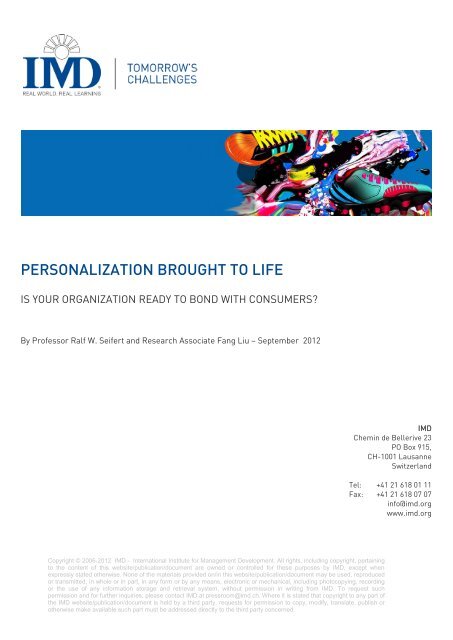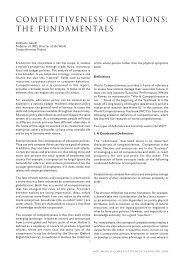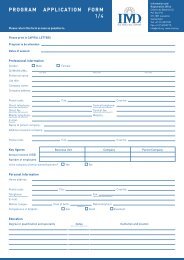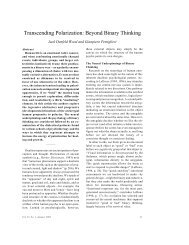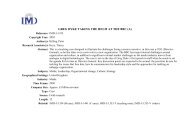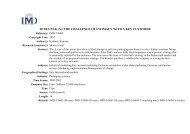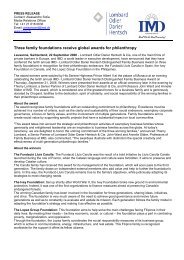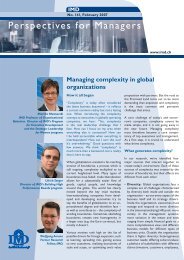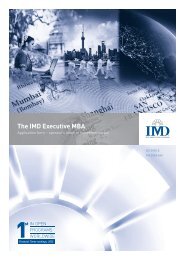PERSONALIZATION BROUGHT TO LIFE - IMD
PERSONALIZATION BROUGHT TO LIFE - IMD
PERSONALIZATION BROUGHT TO LIFE - IMD
Create successful ePaper yourself
Turn your PDF publications into a flip-book with our unique Google optimized e-Paper software.
<strong>PERSONALIZATION</strong> <strong>BROUGHT</strong> <strong>TO</strong> <strong>LIFE</strong><br />
IS YOUR ORGANIZATION READY <strong>TO</strong> BOND WITH CONSUMERS?<br />
By Professor Ralf W. Seifert and Research Associate Fang Liu – September 2012<br />
Copyright © 2006-2012 <strong>IMD</strong> - International Institute for Management Development. All rights, including copyright, pertaining<br />
to the content of this website/publication/document are owned or controlled for these purposes by <strong>IMD</strong>, except when<br />
expressly stated otherwise. None of the materials provided on/in this website/publication/document may be used, reproduced<br />
or transmitted, in whole or in part, in any form or by any means, electronic or mechanical, including photocopying, recording<br />
or the use of any information storage and retrieval system, without permission in writing from <strong>IMD</strong>. To request such<br />
permission and for further inquiries, please contact <strong>IMD</strong> at pressroom@imd.ch. Where it is stated that copyright to any part of<br />
the <strong>IMD</strong> website/publication/document is held by a third party, requests for permission to copy, modify, translate, publish or<br />
otherwise make available such part must be addressed directly to the third party concerned.<br />
<strong>IMD</strong><br />
Chemin de Bellerive 23<br />
PO Box 915,<br />
CH-1001 Lausanne<br />
Switzerland<br />
Tel: +41 21 618 01 11<br />
Fax: +41 21 618 07 07<br />
info@imd.org<br />
www.imd.org
<strong>PERSONALIZATION</strong> <strong>BROUGHT</strong> <strong>TO</strong> <strong>LIFE</strong> I is your organization ready to bond with consumers?<br />
Bonding with consumers in concrete terms is the Holy Grail for most consumer brands. But<br />
operating in today’s world, technology has drastically impacted both the number of messages a<br />
consumer receives and how well communications are digested. Companies looking to develop new<br />
bonds through differentiation, advertising and event marketing must play in a highly competitive<br />
market. But there are still unique ways to reach out to consumers, namely through customization.<br />
Adidas group, the Herzogenaurach-based German sportswear maker, provides a noteworthy<br />
example of customization in action. The company recently launched its new mi team initiative and<br />
will now rollout a full remake of their mi adidas product customization experience. The new<br />
miteam.com site has been exclusively conceived to offer customized sportswear products –<br />
including shoes, clothing and accessories – to schools, universities, leagues and teams who want to<br />
create a team-customized adidas sports kit. Similarly, the miadidas.com site engages consumers<br />
with personalized design and a unique purchasing experience and is expanding on shoe offerings,<br />
while introducing customizable graphic tees starting in October 2012.<br />
Adidas builds on its prior experience in mass customization – a concept which gained traction<br />
during the emergence of the internet economy when early entrants were convinced that the internet<br />
would revolutionize the customization industry by connecting individual customer information with a<br />
computerized global supply chain. Trek Bicycle, a major bicycle manufacture in the US, introduced<br />
its Project One initiative in 2001, which gave consumers the opportunity to customize their Trek bike<br />
online by selecting the bike’s color and components. Grundfos, the world’s largest pump<br />
manufacture from Denmark, also demonstrated how mass customization could work in B2B<br />
markets 1 . Facing the competition from emerging countries, Grundfos customized its product offering<br />
into four categories. The customization strategy improved Grundfos’ inventory turnover and allowed<br />
the company to outperform its initial ROI target.<br />
But offering flexible individual customization to consumers on a volume scale and at a low price is<br />
not an easy task. The mass customization market seemed promising, yet took most market players<br />
much longer than expected to make it work. Some companies even withdrew from the market. Levi<br />
Strauss closed its “Original Spin” operations producing customized jeans in 2004. In the same year,<br />
Customatix.com, offering made-to-order shoes, went off-line after only four years in business. And<br />
after nearly six years of investment, in 2005, Procter & Gamble shut down Reflect.com – a website<br />
selling personalized health and beauty products. Even Dell, the iconic mass customization brand<br />
which used to dominate the US computer market, was hit hard by the emergence of strong players<br />
such as Apple, HP and Lenovo. Today, Dell’s customization options are rather limited.<br />
Even for adidas, enabling mass customization constituted an endeavour not without its difficulties.<br />
At <strong>IMD</strong> we have been following its evolution over the past ten years. Our award-winning case study,<br />
The “mi adidas” Mass Customization Initiative 2 , showcasing adidas' original "mi adidas" initiative<br />
1 Grundfos, Winter Nie and Thomas E. Vollmann, <strong>IMD</strong>-6-0312.<br />
2 “The “mi adidas” Mass Customization Initiative, by Ralf Seifert, <strong>IMD</strong>-6-0249.<br />
<strong>IMD</strong> – www.imd.org Page 2/5
<strong>PERSONALIZATION</strong> <strong>BROUGHT</strong> <strong>TO</strong> <strong>LIFE</strong> I is your organization ready to bond with consumers?<br />
that aimed to deliver customized athletic footwear to retail customers, documents the embedded<br />
cross-functional challenges of making mass customization work. It gives an overview of the<br />
interlinking set of issues – from marketing, retailer selection, and information management, through<br />
to production and distribution, project management and strategic fit – that made expanding adidas’<br />
trial initiative a daunting task. But over time, this very initiative became a cornerstone of adidas’<br />
personalization strategy to fight commoditization risks.<br />
Since the original <strong>IMD</strong> case was written, adidas has gone through a tremendous journey. The<br />
grandiose mi innovation Center on the Champs Elysées in Paris opened in 2007 to offer consumers<br />
the most authentic shoe customization experience using 3D technology. In 2009, as part of its group<br />
strategy “Route 2015,” adidas group announced its “Innovation leadership through personalization”<br />
strategy in which it declared that personalization will be the brand’s lead innovation concept and a<br />
driving force of the adidas business as the company aims to become the most personal sports<br />
brand by 2015. This marked an important milestone and was followed by an expansion at adidas –<br />
mi team products are now available for eleven sports categories and have moved into 16 countries<br />
across North America, Europe and Asia.<br />
However, these achievements were accompanied with pressure from the marketplace. During the<br />
same period, Nike iD, the biggest competitor of mi adidas having also entered the mass<br />
customization game in 2000, grew its business by investing heavily in e-commerce in 2005. In 2010,<br />
Nike iD announced revenues of $100 million for fiscal year 2009. 3<br />
Adidas in turn is stepping up its efforts as a new generation of consumers embraces smart apps<br />
and becomes more at ease with online applications – making the concept even more relevant<br />
today. Driving mass customization experience, mi team is one of the first in the marketplace to<br />
launch the team business, accompanied with the launch of a smart device app. Likewise, mi adidas<br />
designs can now readily be shared among consumers through Facebook, Twitter or e-mail and are<br />
fully integrated into adidas’ e-commerce markets in the US, France, Germany, UK and the<br />
Netherlands.<br />
Today, adidas is able to leverage its hands-on experience and make an important step towards the<br />
future by enabling a consumer-centric supply chain.<br />
With adidas taking a futuristic step forward to engage its consumers, many other players in the field<br />
might suddenly find themselves unprepared, and unable to customize. What makes it so<br />
complicated?<br />
Our research shows that standalone mass customization businesses and mass customization units<br />
in well-established incumbents such as adidas face different challenges. While the incumbent can<br />
provide the mass customization unit with strong resources, brand reputation, and existing<br />
processes, the standalone businesses are more agile in decision making and are more likely to<br />
exert commitment into the business. For many companies that are embarking on a similar journey,<br />
the story of mi adidas can shed some light on their future operations. At the very early stage of<br />
3 http://www.huffingtonpost.com/danny-wong/nikeid-makes-100m-co-crea_b_652214.html<br />
<strong>IMD</strong> – www.imd.org Page 3/5
<strong>PERSONALIZATION</strong> <strong>BROUGHT</strong> <strong>TO</strong> <strong>LIFE</strong> I is your organization ready to bond with consumers?<br />
development, while mi adidas received excellent feedback from consumers and saw great market<br />
potential, challenges in information technology, supply chain and distribution turned out to be more<br />
complex than expected. Internally, it required strong leadership and a commitment from top-down<br />
for a clear positioning of the initiative.<br />
Mass customization represents a new paradigm. Yet getting its front and back-end to work is a<br />
challenging task. Is your organization ready to bond with millions of consumers?<br />
Ralf Seifert is a Professor of Operations Management. His primary research and teaching interests<br />
relate to operations management, supply chain strategy and technology network management.<br />
Fang Liu is a Research Associate at <strong>IMD</strong>.<br />
<strong>IMD</strong> – www.imd.org Page 4/5
<strong>PERSONALIZATION</strong> <strong>BROUGHT</strong> <strong>TO</strong> <strong>LIFE</strong> I is your organization ready to bond with consumers?<br />
Related Programs<br />
ORCHESTRATING WINNING PERFORMANCE - http://www.imd.org/owp<br />
The global business program for individuals and teams<br />
Program Directors Bettina Buechel and Dominique Turpin<br />
- For individuals and teams who seek the latest management thinking and practical, innovative<br />
solutions for their business<br />
- Anticipate global business trends<br />
- Boost your performance, broaden your perspectives and expand your global network<br />
- Design the program that suits you<br />
MANAGING THE GLOBAL SUPPLY CHAIN - http://www.imd.org/mgsc<br />
Growth through agility and efficiency<br />
Program Director Carlos Cordon<br />
- Understand and manage global supply chain complexity and risks<br />
- Protect sales and revenue growth through efficient execution<br />
- Anticipate surprises and avoid problems within your global material, information and financial<br />
flows<br />
- Explore collaboration and various forms of integration that allow you to take advantage of<br />
uncertainty<br />
<strong>IMD</strong> – www.imd.org Page 5/5


